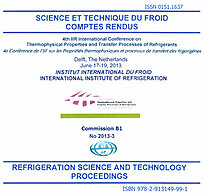
IIR document
Experimental study of semi-clathrate hydrate slurry in a coil heat exchanger.
Number: pap. n. TP-026
Author(s) : VASILESCU C., INFANTE FERREIRA C.
Summary
Air conditioning systems represent a large percentage of energy consumption and greenhouse gases emissions of the building sector. The distribution of cold of these systems could be improved by using two-phase fluids which are more energy efficient because of the latent heat of the solid/liquid phase change. Recently several quaternary salts such as tetrabutylammonium bromide (TBAB) have been proposed for air conditioning applications because their phase change takes place at atmospheric pressure and temperatures above the freezing point of water. This paper is concerned with the experimental analysis of a coil heat exchanger with 6 mm internal diameter with TBAB hydrate slurry.A mixture of 36.5 wt % TBAB and water is cooled at temperatures from 15°C to 10°C until the hydrates forming conditions are reached. The temperature raises when hydrates appear. The pressure drop starts to increase when the hydrates are formed because of the increased viscosity of the fluid. Heat transfer coefficients and pressure drops of 25-45 wt % TBAB hydrate slurry are presented. Local heat transfer correlations are derived from the experiments.
Available documents
Format PDF
Pages: 8 p.
Available
Public price
20 €
Member price*
Free
* Best rate depending on membership category (see the detailed benefits of individual and corporate memberships).
Details
- Original title: Experimental study of semi-clathrate hydrate slurry in a coil heat exchanger.
- Record ID : 30008103
- Languages: English
- Source: 4th IIR Conference on Thermophysical Properties and Transfer Processes of Refrigerants
- Publication date: 2013/06/17
Links
See other articles from the proceedings (69)
See the conference proceedings
-
Design of a fluidized bed heat exchanger for CO...
- Author(s) : ZHOU H., INFANTE FERREIRA C.
- Date : 2013/06/17
- Languages : English
- Source: 4th IIR Conference on Thermophysical Properties and Transfer Processes of Refrigerants
- Formats : PDF
View record
-
Heat transfer and flow characteristics during t...
- Author(s) : ZHOU H., INFANTE FERREIRA C. A.
- Date : 2014/08/02
- Languages : English
- Source: 11th IIR Gustav Lorentzen Conference on Natural Refrigerants (GL2014). Proceedings. Hangzhou, China, August 31-September 2, 2014.
- Formats : PDF
View record
-
A new formation kinetics study method of TBPB a...
- Author(s) : CLAIN P., OSSWALD V., SPIGA O., et al.
- Date : 2015/08/16
- Languages : English
- Source: Proceedings of the 24th IIR International Congress of Refrigeration: Yokohama, Japan, August 16-22, 2015.
- Formats : PDF
View record
-
Experimental investigation and performance char...
- Author(s) : TAMRAPARNI A., RENDALL J., SHEN Z., HUN D., SHRESTHA S.
- Date : 2024/07/15
- Languages : English
- Source: 2024 Purdue Conferences. 8th International High Performance Buildings Conference at Purdue.
- Formats : PDF
View record
-
Study on CO2 hydrate slurry production with add...
- Author(s) : LIU N., CHEN W., DAI H.
- Date : 2012/07/01
- Languages : English
- Source: 10th International Conference on Phase-Change Materials and Slurries for Refrigeration and Air Conditioning. Proceedings: Kobe, Japan, July 29-August 1, 2012.
- Formats : PDF
View record
